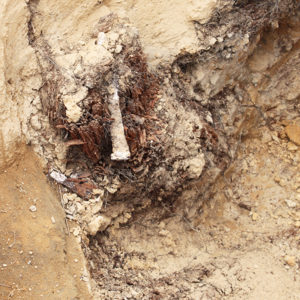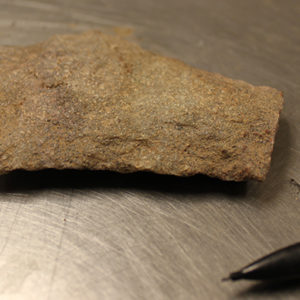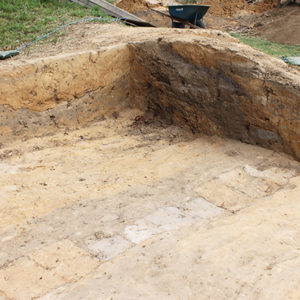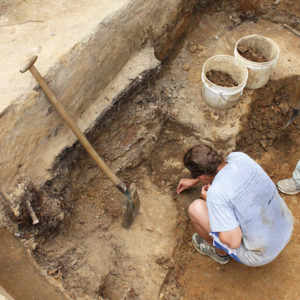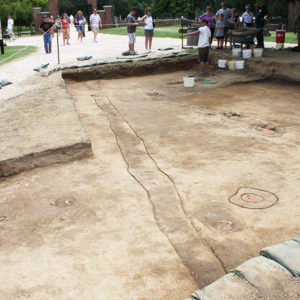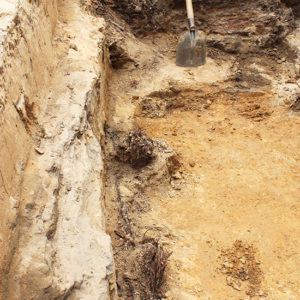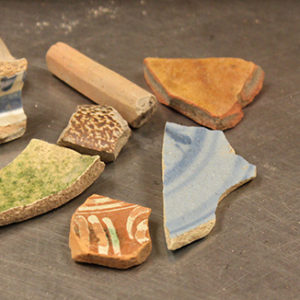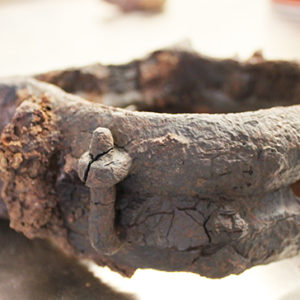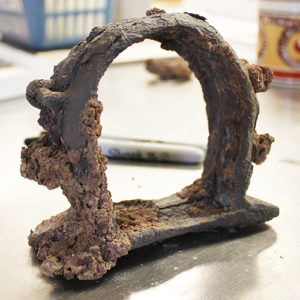The entire archaeological footprint of James Fort’s first substantial church has been found. The church, built in 1608 and which is likely the wedding site of John Rolfe and Pocahontas, can now exactly be defined as 64 feet long and 24 feet wide. All 14 postholes have survived to some extent thanks to the depth at which they were dug. Meanwhile, at the north corner of the fort, work continues on an extension palisade wall that branches out from the original fort’s eastern wall, and which probably was part of the fort expansion that turned the three-sided fort into a five-sided one. While following this palisade wall, another palisade wall was discovered, newer than the extension wall, which may be parallel to the fort’s initial eastern wall. At the fort’s western palisade wall, excavations on Confederate Fort Pocahontas are starting to give form to the bombproof. The shelter was approximately eight feet wide and the wooden supports which held its roof in place are still partially extant. Over 20 iron spikes have been found which were used during the fort’s construction in May 1861.
William Strachey, secretary of the Jamestown colony, wrote that “It is in length three-score foot, in breadth twenty-four . . .” (60 feet by 24 feet). It turns out that he was just a bit off. With the discovery of the church’s western wall, the church can exactly be measured as being 64 feet long and 24 feet wide. The distance between the church’s walls’ postholes is actually 14 feet for the two westernmost segments (wall portions between two postholes) on both the northern and southern sides whereas the three easternmost segments are 12 feet a piece. Senior Staff Archaeologist Danny Schmidt points out that we don’t know how Strachey measured the length, and what inaccuracies were inherent in his method.
The postholes themselves are very deep and every one of them survived to varying degrees thanks to this fact. This area, along with much of the area where James Fort once stood, was mined for dirt to construct Confederate Fort Pocahontas some 250 years after the colonists constructed their fort. Because of this, some of the postholes (as well as many of James Fort’s other features) only partially survive, namely their deepest portions. Inside the postholes, a few artifacts have been found which lead the archaeologists to believe that the church was dismantled rather than let to decay in place. Bermuda limestone was found in one of the holes. Bermuda limestone was recognized by the early colonists as excellent ballasting material and was probably used as ballast to weight the hulls of the Patience and Deliverance, ships constructed in Bermuda by the shipwrecked Jamestown-bound crew of the Sea Venture. Because we know that these first two ships coming from Bermuda arrived in Virginia in 1610, two years after the construction of the church, the limestone could not have been put in the postholes until after removing the existing posts. It is surmised that the remains of the church were probably torn down and removed once the church was relocated in 1617 to the site now occupied by the Jamestown Memorial Church. Like many other holes in James Fort (especially fouled wells) trash and unwanted items were placed inside and this may have been how the limestone came to be in the church’s posthole.
Plaster and ash have also been found in some of the postholes. The plaster may have been part of the church’s walls and the ash may be evidence of the fire that heavily damaged the fort and most of its buildings in January of 1608.
It is notable that no postholes have been found in the middle of the church which seems to suggest that the beams spanning the width of the church were at least 24 feet wide. There have been very few European artifacts found during the church excavations which makes sense considering that the colonists had only been living in the fort for a few months when the church was constructed. Also, because the church was not a residence, domestic artifacts so prevalent in the fort’s other structures are notably absent. A third reason for the lack of fort-period artifacts in the church area is due to the aforementioned mining of the soil here for the construction of the Confederate fort nearby. While the deep postholes survived, anything just inches above would have been reburied as part of Fort Pocahontas’ earthworks.
One exception to the lack of fort-period artifacts was found in the bottom of one of the postholes in the church’s eastern end. The object, about the size of a basket hilt and made of iron, is as-yet unidentified and is the first of its type found since excavations began in 1994. It appears to be a clamping mechanism of some sort, complete with alignment pins and receiving eyes for its two-piece construction. The current educated guess is that it may have served to join two plumbing pipes together. There is much research yet to be done before an identification can be made. Though European artifacts are very scarce in this area, Virginia Indian artifacts are being found in large numbers. Sherds of Native pottery and projectile points are evidence of centuries of Indian activity on Jamestown Island before the English arrived.
Just to the east of James Fort’s northern bulwark, archaeologists are following the soil stain of a palisade wall jutting east off of the original eastern wall. Thought to be part of an extension that turned the original three-sided fort into one with five sides, a total of 69 feet of the wall has been found so far, 31 feet this year and 38 in 2003. The terminus of the wall has not yet been found. During these excavations, another palisade wall was found, this one built later than the fort extension wall. The function of this wall is not known but it appears that it might run parallel to the fort’s original eastern wall. There is evidence to suggest that the fort’s original eastern wall was dismantled rather than left to rot in place, and the presence of a newer wall to the east would certainly suggest that the original wall would be redundant or even a hindrance to the settlers inside.
A number of postholes have been discovered during the excavations. Their purpose is unknown at this point. This area of the site was also altered heavily by earth mining for Fort Pocahontas as well as by farming and its use as a dirt road. Only the very bottom of most of the features here survived. A few European artifacts have been found here including a Nuremberg jetton and some Bartmann jug fragments.
The third current excavation site is located at the bombproof of Fort Pocahontas, situated on top of where a portion of James Fort’s western palisade wall once stood. The width of the bombproof is now known to be eight feet, with archaeologists finding the still-extant remains of wooden posts every two feet along its length. Over 20 iron stakes have been found in and around these wooden posts. The total length of the shelter is unknown at this point because excavations haven’t progressed yet far enough to tell. The bombproof’s eastern end collapsed at some point, perhaps due to fire, although the structure’s western portions didn’t suffer the same fate. On this western side, the soil stains of sandbags have been found. It is interesting to note that Bermuda limestone cobbles are being found here, and it is possible that they were part of the dirt moved by the Confederates from area of the “two fair rows of houses” as limestone was found by archaeologists in the foundations for those structures.
related images
- A stake embedded in one of the wooden posts in Fort Pocahontas’ bombproof
- A fragment of a Virginia Indian Morrow Mountain-type spear point found during the church excavations
- The soil stains from sandbags used at Fort Pocahontas can be seen in the foreground
- Excavating in the bombproof
- Field school student Andrew Ivanchishin interprets the extension excavations for some visitors
- Field School student Kevin Gubbels observes the middle posthole of the church’s western wall
- Fort Pocahontas bombproof remains of wooden posts and planks have survived 150 years underground
- Some of the iron stakes found in Fort Pocahontas’ bombproof
- Some recent small finds from the dig
- Another view of the unidentified iron object
- The unidentified iron object found in one of the church’s postholes



